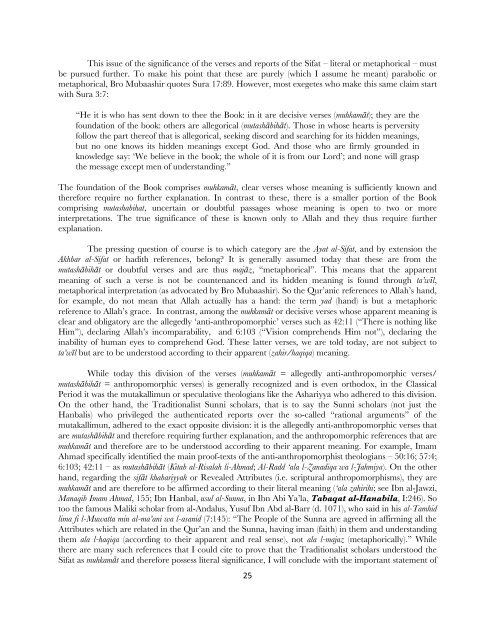Is THEM Guilty of Shirk? - Dr. Wesley Muhammad
Is THEM Guilty of Shirk? - Dr. Wesley Muhammad
Is THEM Guilty of Shirk? - Dr. Wesley Muhammad
You also want an ePaper? Increase the reach of your titles
YUMPU automatically turns print PDFs into web optimized ePapers that Google loves.
This issue <strong>of</strong> the significance <strong>of</strong> the verses and reports <strong>of</strong> the Sifat – literal or metaphorical – must<br />
be pursued further. To make his point that these are purely (which I assume he meant) parabolic or<br />
metaphorical, Bro Mubaashir quotes Sura 17:89. However, most exegetes who make this same claim start<br />
with Sura 3:7:<br />
―He it is who has sent down to thee the Book: in it are decisive verses (muhkamāt); they are the<br />
foundation <strong>of</strong> the book: others are allegorical (mutashābihāt). Those in whose hearts is perversity<br />
follow the part there<strong>of</strong> that is allegorical, seeking discord and searching for its hidden meanings,<br />
but no one knows its hidden meanings except God. And those who are firmly grounded in<br />
knowledge say: ‗We believe in the book; the whole <strong>of</strong> it is from our Lord‘; and none will grasp<br />
the message except men <strong>of</strong> understanding.‖<br />
The foundation <strong>of</strong> the Book comprises muhkamāt, clear verses whose meaning is sufficiently known and<br />
therefore require no further explanation. In contrast to these, there is a smaller portion <strong>of</strong> the Book<br />
comprising mutashabihat, uncertain or doubtful passages whose meaning is open to two or more<br />
interpretations. The true significance <strong>of</strong> these is known only to Allah and they thus require further<br />
explanation.<br />
The pressing question <strong>of</strong> course is to which category are the Ayat al-Sifat, and by extension the<br />
Akhbar al-Sifat or hadith references, belong? It is generally assumed today that these are from the<br />
mutashābihāt or doubtful verses and are thus majāz, ―metaphorical‖. This means that the apparent<br />
meaning <strong>of</strong> such a verse is not be countenanced and its hidden meaning is found through ta‟wīl,<br />
metaphorical interpretation (as advocated by Bro Mubaashir). So the Qur‘anic references to Allah‘s hand,<br />
for example, do not mean that Allah actually has a hand: the term yad (hand) is but a metaphoric<br />
reference to Allah‘s grace. In contrast, among the muhkamāt or decisive verses whose apparent meaning is<br />
clear and obligatory are the allegedly ‗anti-anthropomorphic‘ verses such as 42:11 (―There is nothing like<br />
Him‖), declaring Allah‘s incomparability, and 6:103 (―Vision comprehends Him not‖), declaring the<br />
inability <strong>of</strong> human eyes to comprehend God. These latter verses, we are told today, are not subject to<br />
ta‟wīl but are to be understood according to their apparent (zahir/haqiqa) meaning.<br />
While today this division <strong>of</strong> the verses (muhkamāt = allegedly anti-anthropomorphic verses/<br />
mutashābihāt = anthropomorphic verses) is generally recognized and is even orthodox, in the Classical<br />
Period it was the mutakallimun or speculative theologians like the Ashariyya who adhered to this division.<br />
On the other hand, the Traditionalist Sunni scholars, that is to say the Sunni scholars (not just the<br />
Hanbalis) who privileged the authenticated reports over the so-called ―rational arguments‖ <strong>of</strong> the<br />
mutakallimun, adhered to the exact opposite division: it is the allegedly anti-anthropomorphic verses that<br />
are mutashābihāt and therefore requiring further explanation, and the anthropomorphic references that are<br />
muhkamāt and therefore are to be understood according to their apparent meaning. For example, Imam<br />
Ahmad specifically identified the main pro<strong>of</strong>-texts <strong>of</strong> the anti-anthropomorphist theologians – 50:16; 57:4;<br />
6:103; 42:11 – as mutashābihāt (Kitab al-Risalah li-Ahmad; Al-Radd „ala l-Zanadiqa wa l-Jahmiya). On the other<br />
hand, regarding the sifāt khabariyyah or Revealed Attributes (i.e. scriptural anthropomorphisms), they are<br />
muhkamāt and are therefore to be affirmed according to their literal meaning („ala zahirihi; see Ibn al-Jawzi,<br />
Manaqib Imam Ahmad, 155; Ibn Hanbal, usul al-Sunna, in Ibn Abi Ya‘la, Tabaqat al-Hanabila, I:246). So<br />
too the famous Maliki scholar from al-Andalus, Yusuf Ibn Abd al-Barr (d. 1071), who said in his al-Tamhid<br />
lima fi l-Muwatta min al-ma‟ani wa l-asanid (7:145): ―The People <strong>of</strong> the Sunna are agreed in affirming all the<br />
Attributes which are related in the Qur‘an and the Sunna, having iman (faith) in them and understanding<br />
them ala l-haqiqa (according to their apparent and real sense), not ala l-majaz (metaphorically).‖ While<br />
there are many such references that I could cite to prove that the Traditionalist scholars understood the<br />
Sifat as muhkamāt and therefore possess literal significance, I will conclude with the important statement <strong>of</strong><br />
25
















